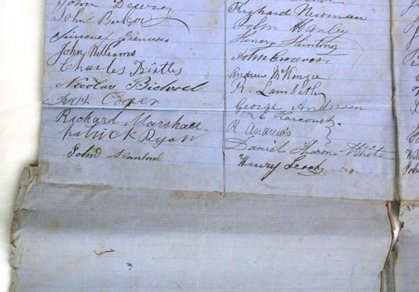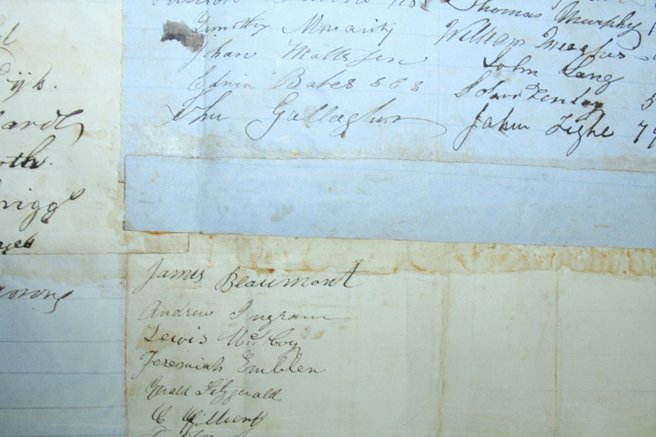Paul Smith is a Conservator working at State Records NSW
The Petition
The petition is from 1862 and was initiated in protest to the sentencing of William Spicer, who was convicted for his involvement in rioting against the Chinese community at Lambing Flats gold fields in 1861. The individual collated sheets of signatures were pasted together, 2 abreast and then end to end to form a single 13 metre long document. For storage, the petition was folded in half lengthways, and then compactly rolled over and over.
The Problem
The problem for anyone who wanted to read the document was that in order to open up the petition, the entire length needed to be unrolled first. Once unrolled, there was the issue of trying to safely open a 13 metre fold! Most of the pages were in relatively good condition, but there were signs of wear and strain due to the way it had been constructed. What was required was to repair the tears and relieve some of the inherent tension, and then to come up with an adequate storage solution.
Because the petition is made up of sheets of paper of varying sizes, getting it all to fit had inherent problems. Slightly larger sheets would be loose and liable to crease when they were stuck to a smaller sheet, whereas the smaller sheet would potentially tear. Also, some of the signatures were pasted underneath corresponding sheets.
The Treatment
The petition was unrolled along a cleared corridor and then three conservators carefully unfolded it. It was then rolled back onto a large cardboard cylinder, where it could be un-wound a little at a time for repair.
Most of the pasted pages needed to be released and re-aligned. Animal glue swells and softens with water, but care must be taken as too much moisture can create further stains or make soluble inks run.
Water was introduced through a membrane that allowed better control over the moisture penetrating the document. The paste eventually swelled and softened enough to be able to lift the pages and re-attach.
Once released, excess animal glue was cleaned and where needed, the pages were flattened and repaired. Then they were finally re-attached using repair tissue and wheat-starch paste. The newly repaired section of the scroll was rolled on a bit further and the repair process continued.
One aspect of being only able to work on a small section at a time was that it made it very difficult to judge the overall alignment of the scroll. Adjusting all of those pages did not make it easy to roll the petition neatly. To give it some room to move, it was inter-leaved with a length of Remay tissue (spun polyester) and loosely rolled onto a cardboard cylinder. A new box was made where the weight of the petition could be held by the edges of the cylinder and not the actual document.
The treatment resulted in the petition moving from within a relatively small file to rehousing it into a rather large and complicated box. Still, at least we can now read what it has to say. And for the record, it seems that the appeal did not work and William Spicer was forced to remain in prison.
Edited to change the title of the post from “Rolling back into history (Conserving an 1862 Lambing Flat Petition) to “Rolling back into history (Conserving a 13 metre petition from 1862)” following information provided by Jean Little and Max Thomas. Both sources noted that while the petition concerned William Spicers’ sentence stemming from his conviction for participating in the Lambing Flat riots, the petition itself originated in the Lachlan River Gold Fields and therefore the title was misleading.






Jean Little says:
Thank you for showing us the conservation of the Spicer Petition.
The petition was certainly about William Spicer and his role in the Lambing Flat Riots (now Young). However, this petition appears to have been made up at the Lachlan Gold Fields (now Forbes).
Many of the miners & storekeepers from Lambing Flat moved to the Lachlan when gold was found. This petition was prepared at the height of the Lachlan rush.
Anyone who can make corrections or add to this surmise, we would be greatly appreciate their comments.
In any case, Forbes Family History Group is currently composing an index to the Spicer petition.
Jean Little says:
P.S. There appears to be approximately 4500 signatures to the petition.
Fiona Sullivan says:
Thanks for the information @Jean Little. I would be interested to hear about the progress of the index.
Jean Little says:
Yes Fiona, I’ll certainly let you know the progress of the index. At the moment, it is in very basic form, but if the person signed his name in a legible way, then we would probably be able to find him.
That doesn’t necessarily mean the people more used to writing are the most legible !
Barbara Bull says:
How exciting to read this. William Spicer is my great-grandfather. I have recently become aware of this petition via the Sydney Morning Herald of 1862. How amazing to think it still survives! Is there a possibility of viewing it?